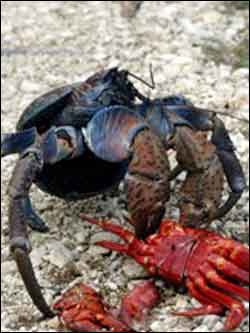It came from the sea: ’Monster’ crabs evolve a bug’s nose

New results show that land-living crabs, descended from marine ancestors, have re-invented key aspects of the insect nose through evolution in order to solve the problem of olfaction in their air-filled terrestrial environment.
The robber crab, Birgus latro, is the world’s largest land-dwelling arthropod, with a weight reaching 4 kg and a length of more than half a meter. Robber crabs are perhaps most famous for their ability to climb tall palm trees in search of coconuts, which they later are able to crack open with their massive claws. These crabs are fully adapted to a life on land and will actually drown if submerged in water. The robber crab’s transition from sea to land has been accomplished through numerous, and in many cases far-reaching, adaptations. A question not previously addressed is how the robber crabs have adapted to olfaction in their new environment – an intriguing question because the sense of smell needs to operate under very different conditions in air compared to water.
In the new work, Marcus Stensmyr and Bill S. Hansson from the Swedish University of Agricultural Sciences, together with colleagues from Lund University, Sweden and the University of New South Wales, Australia, show not only that these impressive crabs have a functional sense of smell but that the olfactory system they have developed is in fact highly sophisticated and sensitive. Moreover, the crabs have managed this evolutionary feat by adopting olfactory strategies similar to those of insects.
Remarkably, the similarities between the crab and insect olfactory systems extend to functional, behavioral, and structural characteristics. The “insect nose” of the robber crab is a striking example of convergent evolution and nicely illustrates how similar needs of very distantly related organisms may cause similar end results.
Media Contact
All latest news from the category: Life Sciences and Chemistry
Articles and reports from the Life Sciences and chemistry area deal with applied and basic research into modern biology, chemistry and human medicine.
Valuable information can be found on a range of life sciences fields including bacteriology, biochemistry, bionics, bioinformatics, biophysics, biotechnology, genetics, geobotany, human biology, marine biology, microbiology, molecular biology, cellular biology, zoology, bioinorganic chemistry, microchemistry and environmental chemistry.
Newest articles

Sea slugs inspire highly stretchable biomedical sensor
USC Viterbi School of Engineering researcher Hangbo Zhao presents findings on highly stretchable and customizable microneedles for application in fields including neuroscience, tissue engineering, and wearable bioelectronics. The revolution in…

Twisting and binding matter waves with photons in a cavity
Precisely measuring the energy states of individual atoms has been a historical challenge for physicists due to atomic recoil. When an atom interacts with a photon, the atom “recoils” in…

Nanotubes, nanoparticles, and antibodies detect tiny amounts of fentanyl
New sensor is six orders of magnitude more sensitive than the next best thing. A research team at Pitt led by Alexander Star, a chemistry professor in the Kenneth P. Dietrich…





















